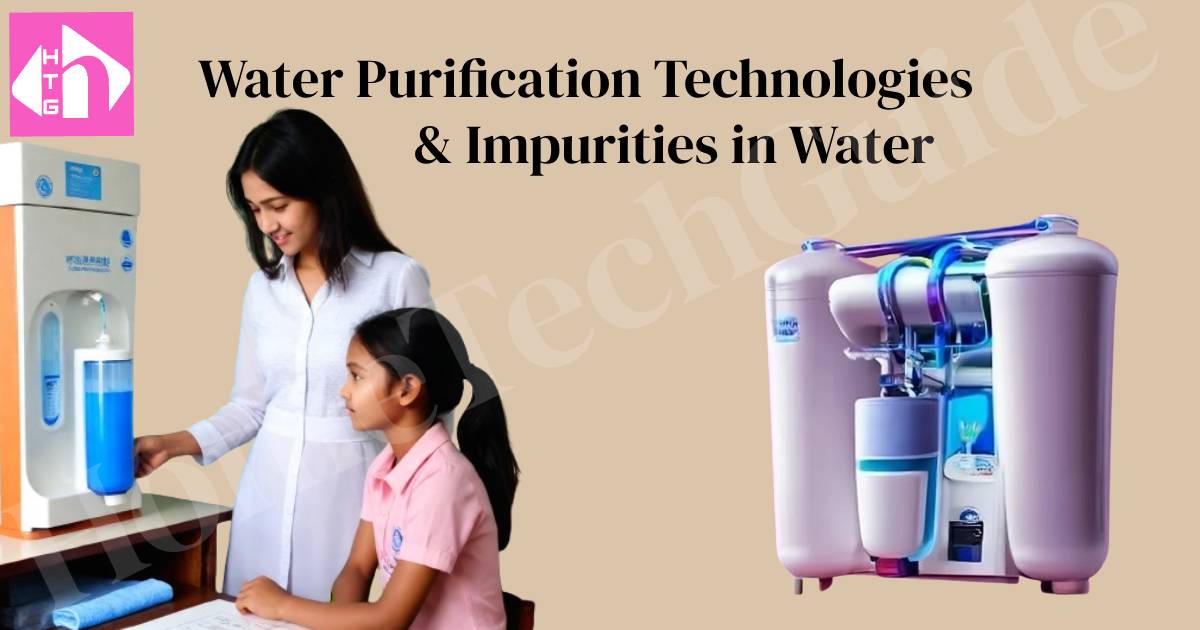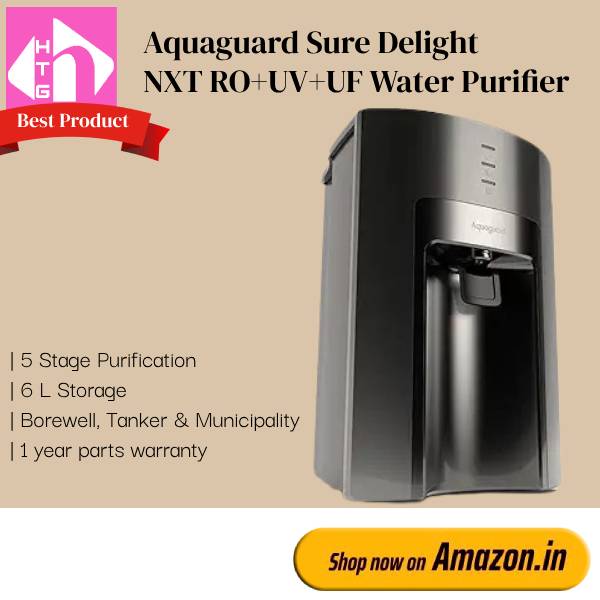Water purification technologies apply to two perspectives; one, water purification for home use, and the other for industries. Since we talk about home appliances and other value goods, we will discuss the one applied to water purifiers for homes.

Water is a critical living need, and comes with impurities mostly. There are many reasons for water getting impure, and most of them are man-made reasons. These impurities had to be removed and neutralised to make the water compatible with our digestion system, giving us health and happiness.
Now, there can be different levels of impurities for geographical reasons, and applying a single water purification technology to meet the cleaning needs may not be a healthy approach. Thus, different water purification technologies evolved analysing the varying purification needs.
In this article, we will uncover insights into these different water purification technologies, including the various impurities found in water. The insights will help you select the right water purification technology for your family and choose the best water purifier. We will also look at some best-selling water purifiers under each technology to help you meet the objective of buying the perfect water purifier, at one go.
So, without any further delay, let’s start!
Water Purification Technologies in Domestic Use
1) UV ( Ultra Violet)
The UV technology does not remove the dissolved solids or any other suspended impurities in water. It only kills the biological microorganisms in water or damages their DNA so that they do not replicate in our bodies if consumed. Most water purifier manufacturers prefer to sell water purifiers integrated with UV water purification technology as the unit ensures pure water free from biological impurities. We too encourage this.
The mastery of this technology is passing ultraviolet radiation in the wavelength range of 198 nm to 400 nm through the water to kill germs or damage their DNA.
Tips for buying a UV water purifier
When buying a UV water purifier, choose a unit which has the UV chambers installed in the horizontal direction. When laid flat, there is a swirling motion of water, and an excellent contact ratio between the light and microorganisms is feasible. However, this factor should not become a reason for rejecting a water purifier, which has other good reasons to buy.
ii) UF (Ultra Filtration)
The UF (Ultra Filtration) water purification technology purifies water by filtering it under gravity pressure without the use of electricity. This makes them the best water purifiers for places with little or no access to electricity. Also, the UF water purifiers are cheap compared to the rest of the water purification technologies.
Water passes through Ultra Filteration semi-permeable membrane bearing micro holes of the size in the range of 0.1 to 0.01 microns. The holes in the semi-permeable layer are small enough to counter all types of suspended impurities and colloidal impurities, including harmful bacteria and other microorganisms.
This implies that the UF water purifiers can be suitable at places where the TDS in water is within permissible limits, we recommend buying a UF water purifier integrated with UV water purification technology to take care of the biological impurities, though. The UF water purifiers can be ideal for houses using municipal water supplies to take care of the impurities collected during transportation from municipal corporations to the user’s house.
Tips for buying UF Water Purifiers
- The possibility of tiny microorganisms passing through the membrane cannot be ruled out. The smallest known virus, so far (Source: Wikipedia), is 17 NM in dia (equivalent to 0.017 microns), which is close to the size of pores in the UF membrane. Hence, we recommend using this water purification technology with a UV radiation chamber, if you do not have electricity access issues in your area.
- Membranes in UF water Purifiers are available in two types: The small hollow pipe-type membrane and the Spiral layout membrane. Prioritize the latter when buying a UF water purifier.
iii) RO (Reverse Osmosis)
RO, Reverse Osmosis, by far, is the most advanced water purification technology. It employs passing impure water under pressure through a semipermeable membrane. The pores of the semipermeable membranes are 0.0001 microns in size, making them fine enough to remove most of the dissolved solids, including microorganisms.
Depending upon the initial TDS content, RO membranes remove up to 90 % of TDS, leaving a minimal quantity of minerals essential for health. The TDS content is RO purified water usually lies in the range of 20-50 PPM. Drinking mineral-less water comes with health disadvantages, our body needs a minimum of minerals to regulate the digestive system’s functioning efficiently. So modern RO purifiers employ Alkaline cartridges to increase the TDS content of the purified water and give an improved PH value.
Tips for buying RO water purifiers
- There is a minimum limit to consuming minerals These may be called essential minerals that our body needs to function efficiently. Please check BIS recommendations for TDS in water. When buying an RO water purifier, please ensure you get the one with additional mineral cartridges. As stated, the mineral content in RO purified is much reduced, so make sure the health essentials are covered with mineral intake in the right quantity.
- Make sure you keep a TDS meter and a PH meter in place to monitor the purified water quality, especially when you feel tastelessness in the purified water. We would recommend getting one from the below listed TDS meters if you still need to own one.
iv) MF (Micro Filtration Technology)
Some of the best water purifiers use MF in addition to the RO and UV water purification technologies. The MF terminology stands for Microfiltration which works similarly to the UF technology, the difference lies in the hole sizes inside the membrane.
v)NF (Nano Filtration Technology)
Nanofiltration is an intermediate technology between the UF and the RO. Membrane pores in NF technology lie in the range of 0.01 to 0.001 microns. This technology can retain 40 to 70% of minerals found as TDS in water, fulfilling our body’s mineral needs efficiently. The PH of purified water is also improved with the NF technology filters.
Since we are discussing the water purification technologies aimed at removing impurities in water, getting a glimpse into various water impurities will strengthen our awareness and help us make better and informed decisions. Let’s discuss the impurities in water in the next section.
Impurities in Water
Impurities in water are just the opposite of what the characteristics of water define. In its natural form, water is free from any content, whether useful or harmful to health. But as it passes through the different mediums, it carries many minerals and natural extracts present on the earth’s surface; unfortunately, it takes some impurities too. These impurities are mostly the chemical waste from industries or human-made contaminants buried in soil.
Broadly, impurities exist in three forms in water:
- Suspended form
- Dissolved form, and
- Colloidal form
Let’s understand them one by one
- Suspended impurities: These impurities are found in the solid form in water, as particles.
The suspended particles’ size is 1 Um and above (regarded as suspended up to 10 Um). Their presence in water makes the water Turbid. The physical visibility of the extent of Turbidity in drinking water depends on the amount of suspended impurities in the water. Generally, Turbidity is visible in the water when the suspended impurities are more than 5 PPM.
Some examples of these impurities are Silt, Clay, sand, decays of vegetational matter, and microorganisms like algae, bacteria, Protozoa, fungi, etc.
- Dissolved Impurities: Dissolved impurities include:
- Organic compounds like pesticides, animal and plant decay deprivations, herbicides, etc.
- Inorganic ions such as calcium, magnesium, fluorides, chlorides, sulphates, nitrates, etc.
- Dissolved gases like Nitrogen, Carbon dioxide, and Oxygen. These can alter the PH of water and cause acidity in the human digestive system.
- Dissolved impurities make the water harder. More the dissolved solids, more harder would be the water. Also, dissolved impurities have a direct relation with the colour of water, making them look darker when rising dissolved impurities.
Wrapping Up:
Exploring the impurities and the different water purification technologies can help understand the water chemistry, empowering you to make the right decisions for selecting a water purifier that suits your health’s needs.
We hope you find the above explanations helpful. If so, please share this article with your loved ones. If you have more queries, please feel free to write to us through the comment section below. We have kept it open for you.
Thank You!




